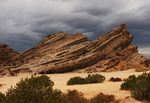Vasquez Rocks: Difference between revisions
No edit summary |
No edit summary |
||
| Line 11: | Line 11: | ||
In 1874, Tiburcio Vásquez, one of California's most notorious bandits, used these rocks to elude capture by law enforcement. His name has since been associated with this geologic feature. | In 1874, Tiburcio Vásquez, one of California's most notorious bandits, used these rocks to elude capture by law enforcement. His name has since been associated with this geologic feature. | ||
The land and rock formations were acquired gradually by Los Angeles County, beginning with a donation of 40 acres in 1971, with more parcels being added through 2001. | The land and rock formations were acquired gradually by Los Angeles County, beginning with a donation of 40 acres in 1971, with more parcels being added through 2001. The Pacific Crest Trail crosses through the park. | ||
Vasquez Rocks was added to the National Register of Historic Places (site #72000228) in 1972 because of its significance as a prehistoric site for the Shoshone and Tataviam peoples. | Vasquez Rocks was added to the National Register of Historic Places (site #72000228) in 1972 because of its significance as a prehistoric site for the Shoshone and Tataviam peoples. | ||
Revision as of 14:23, 11 October 2019
Vasquez Rocks Natural Area Park is a 932-acre (377-hectare) park located in the Sierra Pelona Mountains in northern Los Angeles County, California. It is located in the town of Agua Dulce, between the suburbs of Santa Clarita and Palmdale. The area is also visible from the Antelope Valley Freeway (State Route 14).
History
These rock formations were formed by rapid erosion during uplift about 25 million years ago, and then later exposed by uplift activity along the San Andreas Fault.
The Tataviam people were living here when the Spanish arrived. Their language was most likely a Takic Uto-Aztecan language. They lived in grass huts within villages. With the coming of the Spanish missions, some of these people were forced to work there. They eventually began speaking Spanish and inter-marrying with other tribes. The last of the Tataviam people died in 1916.
In 1874, Tiburcio Vásquez, one of California's most notorious bandits, used these rocks to elude capture by law enforcement. His name has since been associated with this geologic feature.
The land and rock formations were acquired gradually by Los Angeles County, beginning with a donation of 40 acres in 1971, with more parcels being added through 2001. The Pacific Crest Trail crosses through the park.
Vasquez Rocks was added to the National Register of Historic Places (site #72000228) in 1972 because of its significance as a prehistoric site for the Shoshone and Tataviam peoples.
Role in entertainment
Further information: List of productions using the Vasquez Rocks as a filming location
In 1935, Universal Pictures assigned Stanley Bergerman as executive producer on the film Werewolf of London. Bergerman suggested Vasquez Rocks as the filming location used to portray Tibet. Since then, its location inside the Thirty-mile studio zone (aka:"TMZ") has ensured Vasquez Rocks' repeated usage in motion pictures, television series, and advertising.
Chat rooms • What links here • Copyright info • Contact information • Category:Root
